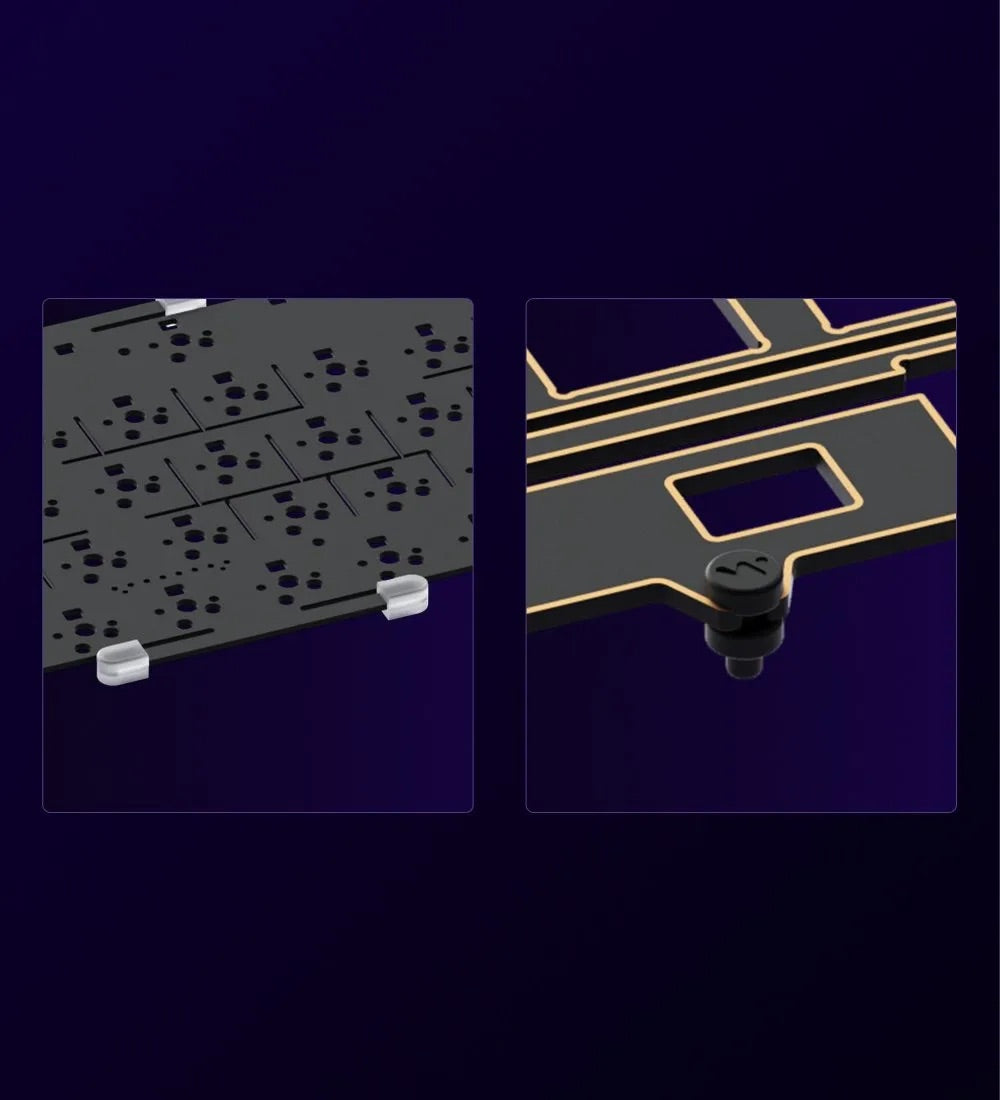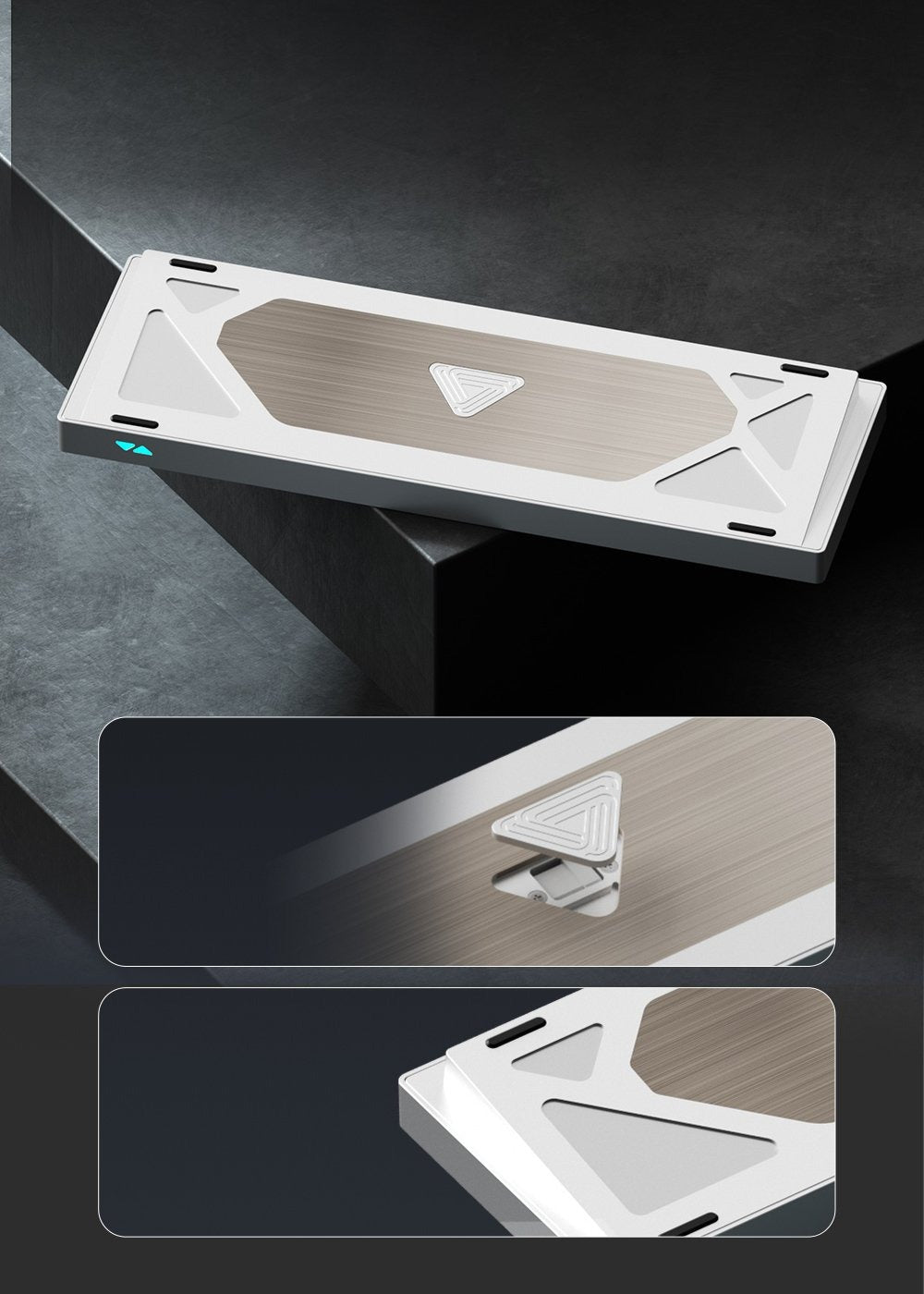When building or choosing a custom mechanical keyboard, one of the most important factors that determines the overall typing feel and sound profile is the mounting style. Mounting style refers to how the keyboard’s plate and PCB are secured inside the case. This directly affects the flexibility, acoustics, vibration, and typing comfort of your board. Whether you’re a beginner or a seasoned enthusiast, understanding each mounting style will help you find the perfect keyboard experience.
What Is a Keyboard Mounting Style?
The mounting style defines how the internal components — mainly the plate (which holds the switches) and the PCB (printed circuit board) — are attached to the keyboard case. The way these parts are mounted impacts how much the board flexes when typing, how vibrations are transferred, and what the overall sound signature will be. The most common mounting types include tray mount, top mount, gasket mount, bottom mount, plateless mount, and burger mount.
1. Tray Mount
Tray mount keyboards are among the most common and budget-friendly mounting styles. In a tray mount, the PCB is screwed directly into standoffs on the bottom of the keyboard case, usually at several points. This design is often seen in entry-level or mass-produced keyboards.
Pros: Affordable, simple design, and widely available. Cons: Can lead to uneven typing feel and less consistent acoustics because the screws create pressure points. Sound/Feel: Stiffer and less flexible, with a slightly hollow sound depending on the case material.
2. Top Mount
Top mount keyboards secure the plate to the top half of the case using screws. This isolates the typing plate from the bottom shell, offering a more consistent feel and often improved sound. It’s a classic and reliable design used in many high-end custom keyboard kits.
Pros: Balanced and consistent typing feel, enhanced acoustic response, stable construction. Cons: Slightly firmer than gasket mounts and less flex overall. Sound/Feel: Crisp and solid with good feedback. It produces a satisfying “thock” sound depending on foam layers and case material.
3. Gasket Mount
Gasket mount keyboards have become one of the most popular styles in the custom keyboard community. In this design, the plate is sandwiched between gasket materials (often made of Poron or silicone foam) that isolate the plate from direct contact with the case. This results in softer keystrokes and improved acoustic dampening.
Pros: Excellent flexibility, smoother typing experience, great sound isolation, and premium feel. Cons: Slightly more expensive to produce, and not everyone prefers the “bouncy” typing feel. Sound/Feel: Soft, dampened, and flexible. Creates a muted “thock” or “marbly” tone that many enthusiasts love.
4. Bottom Mount
In a bottom mount keyboard, the plate is attached to the bottom case instead of the top. While not as common today, it offers a solid and firm typing feel because the plate sits close to the desk surface.
Pros: Stable and rigid typing experience. Cons: Limited availability and slightly harsher bottom-out feel. Sound/Feel: Deeper sound profile with minimal flex.
5. Burger Mount
The burger mount is a variation of the top mount, where rubber or silicone O-rings are placed between the screw and the plate. This reduces vibration transfer and allows for a slightly softer feel without changing the structure much.
Pros: Reduces harsh vibrations, improves comfort, easy mod for existing top mounts. Cons: Requires fine-tuning to achieve ideal consistency. Sound/Feel: Slightly softer and quieter than traditional top mount designs.
6. Plateless Mount
In a plateless keyboard, the switches are soldered directly to the PCB without using a mounting plate. This allows for maximum flexibility and a soft, cushion-like typing experience that many typists prefer for long sessions.
Pros: Extremely flexible, unique feel, lighter typing force. Cons: Harder to build, less structural support, not ideal for hot-swap PCBs. Sound/Feel: Very soft and deep, with a “cloud-like” typing sensation.
How Mounting Style Affects Sound and Feel
The mounting method has a significant impact on both typing acoustics and feedback:
- Sound: Harder mounts (tray, top, bottom) generally produce louder, sharper sounds, while softer mounts (gasket, plateless) create deeper and more muted tones.
- Feel: Stiffer mounts provide stability and control, great for gaming, while flexible mounts enhance comfort for typing.
- Vibration: Gasket and burger mounts help absorb vibrations, reducing finger fatigue and providing a premium experience.
Which Mounting Style Is the Best?
There’s no single “best” mounting style—it depends on your preferences and intended use. If you love a crisp and consistent typing experience, a top mount keyboard might be ideal. For those seeking soft, dampened acoustics and a bouncy feel, gasket mount keyboards offer unmatched comfort. Tray mounts remain excellent for budget builds or first-time builders, while plateless designs cater to enthusiasts chasing ultimate flex and sound customization.
Conclusion
Choosing the right mounting style is just as important as picking your switches or keycaps. The mount affects every keystroke you make—from the sound signature to the typing comfort. If you’re building a custom keyboard, take time to explore how each design fits your typing style. Whether it’s a top mount for stability or a gasket mount for softness, the best mounting style is ultimately the one that feels right under your fingertips.






